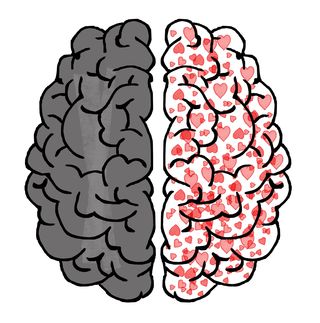Relationships
The Prefrontal Cortex and Long-Term Romance
In romance, a wandering eye may be less cause for concern than a wandering mind.
Posted March 13, 2018

When Homer’s epic poem The Odyssey opens, the hero Odysseus is sitting on the shore of the island Ogygia weeping. After spending ten years fighting the Trojan War, and several more years trying to make his way back home to Ithaca, he finds himself trapped on Ogygia by a goddess who has fallen in love with him and wants to make him her husband. So desperately does Calypso want to marry Odysseus that she offers him everything she can think of—including immortality—to win him over, but all he can think of is returning home to be with his wife Penelope. Even after twenty years of separation, his attachment to her is just as strong as it was when he last saw her before setting sail for Troy.
Such an epic display of fidelity might conventionally be interpreted as springing from a heartfelt emotional attachment, but a recent neuroimaging study at Kyoto University in Japan suggests that Odysseus’s long-term devotion to Penelope has less to do with his heart than with his brain. Trying to distinguish between the neural mechanisms at work in long-term romantic attachments such as that of Odysseus for Penelope, and those involved in the sort of “intense passionate love” more typical of the early stages of a relationship, researchers designed an experiment to identify the role that the brain’s executive control functions play in both types of relationships. Fifty-five volunteers between the ages of 20 and 39 participated in the study. The participants were all males (because of their higher statistical probability, as compared to females, to seek multiple romantic relationships,) who were not married, but were currently in a relationship that had lasted for at least six months.
In the first part of the experiment, participants completed a “go/no-go” task while in a functional magnetic resonance imaging (fMRI) scanner. Presented with a series of images of cats and dogs, they were instructed to press a button for the cat pictures, and to refrain from pressing the button for the dog pictures. Such a task is often used to measure brain activation during response inhibition—the foundation of executive control—and since increased activation of the right ventrolateral prefrontal cortex (VLPFC) during response inhibition predicts a number of successful self-regulatory behaviors, the researchers focused on this parameter as they sought a correlation between participants’ executive control and their regulation of interest in extra-pair relationships.
In the second part of the experiment, participants completed a “date-rating task,” outside the scanner, in which they rated their level of interest in dating unfamiliar females. Presented with a series of 48 female faces, they were asked to rate how interested they would be in dating each female. Participants’ responses to this task were correlated with the measure of their right VLPFC activation from the first part of the experiment, and then this correlation—of VLPFC activation and interest in extra-pair relationships—was analyzed in relation to the duration of each participant’s current romantic relationship.
As hypothesized, in participants who had been involved in their relationships for a longer period of time, increased activation of the VLPFC was positively correlated with their successful inhibition of interest in extra-pair relationships. Participants who had been in their relationships for a shorter period of time, on the other hand, exhibited no such correlation. The relative degree of executive control they exhibited in the first part of the experiment had no apparent connection with their ability to inhibit extra-relationship temptation in the second part.
The implications of these results are obvious, and provide objective support for our subjective impression that the degree of cognitive control required to maintain romantic relationships evolves over time. In the early stages of a romantic relationship, passionate “addictive” love is driven by automatic tendencies through which motivation to remain with one’s significant other is sustained by reward systems in the brain, and thus requires no substantial cognitive control. For a relationship to endure beyond this early addictive phase, however, executive control—supported by the prefrontal cortex—takes over a portion of the responsibility for inhibiting the desire to seek greener pastures elsewhere as the reward systems become less intensely involved in maintaining control.
In addition to his love for Penelope, Odysseus was famous for his problem-solving skills, such as his scheme for escaping the cave of the blinded Cyclops by hanging onto the underbelly of the monster’s sheep as he let them out to graze. The ability to craft such a clever stratagem for survival might appear to be completely unrelated to long-term commitment in a romantic relationship, but, as the Kyoto study indicates, the executive control of the prefrontal cortex plays just as important a role in the latter as in the former. And while it is certainly not the case that good problem-solving skills in and of themselves predict the likelihood of long-term commitment to a relationship, the involvement of the prefrontal cortex associated with problem-solving is at least suggestive of the sort of impulse control required for “the maintenance of long-term goals,” whether those goals happen to involve overcoming the wrath of Poseidon to get back home to Penelope, or simply hanging in there with our significant other until retirement so we can grow old together in rocking chairs before the fireplace.
References
Ueda, R., Yanagisawa, K., Ashida, H. et al. “Executive Control and Faithfulness: Only Long-Term Romantic Relationships Require Prefrontal Control.” Experimental Brain Research (2018) 236: 821.


